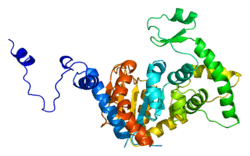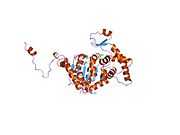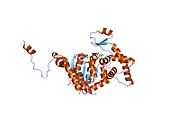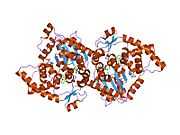DHPS
This article is about the gene coding for the enzyme deoxyhypusine synthase. For another enzyme commonly abbreviated DHPS, see Dihydropteroate synthetase. For other uses, see DHPS (disambiguation).
Deoxyhypusine synthase is an enzyme that in humans is encoded by the DHPS gene.[1][2]
The unusual amino acid hypusine is formed posttranslationally and is only found in a single cellular protein, eukaryotic translation initiation factor 5A. In the first step of hypusine biosynthesis, deoxyhypusine synthase catalyzes the NAD-dependent transfer of the butylamine moiety of spermidine to the epsilon-amino group of a specific lysine residue of the EIF5A precursor protein to form the intermediate deoxyhypusine residue. This gene consists of nine exons spanning 6.6 kb. Three transcript variants have been isolated. However, only transcript variant 1 encodes an active protein. The shorter variants may act as modulating factors of DHPS activity.[2]
References
- ↑ Joe YA, Wolff EC, Park MH (Oct 1995). "Cloning and expression of human deoxyhypusine synthase cDNA. Structure-function studies with the recombinant enzyme and mutant proteins". J Biol Chem 270 (38): 22386–92. doi:10.1074/jbc.270.38.22386. PMID 7673224.
- ↑ 2.0 2.1 "Entrez Gene: DHPS deoxyhypusine synthase".
Further reading
- Klier H; Csonga R; Steinkasserer A et al. (1995). "Purification and characterization of human deoxyhypusine synthase from HeLa cells". FEBS Lett. 364 (2): 207–10. doi:10.1016/0014-5793(95)00394-O. PMID 7750572.
- Joe YA, Park MH (1994). "Structural features of the eIF-5A precursor required for posttranslational synthesis of deoxyhypusine". J. Biol. Chem. 269 (41): 25916–21. PMID 7929297.
- Bevec D; Kappel B; Jaksche H et al. (1996). "Molecular characterization of a cDNA encoding functional human deoxyhypusine synthase and chromosomal mapping of the corresponding gene locus". FEBS Lett. 378 (2): 195–8. doi:10.1016/0014-5793(95)01456-X. PMID 8549832.
- Yan YP, Tao Y, Chen KY (1996). "Molecular cloning and functional expression of human deoxyhypusine synthase cDNA based on expressed sequence tag information". Biochem. J. 315 (2): 429–34. PMC 1217213. PMID 8615810.
- Andersson B; Wentland MA; Ricafrente JY et al. (1996). "A "double adaptor" method for improved shotgun library construction". Anal. Biochem. 236 (1): 107–13. doi:10.1006/abio.1996.0138. PMID 8619474.
- Jones T; Sheer D; Kapetanopoulos A et al. (1996). "The gene coding for human deoxyhypusine synthase (DHPS) maps to chromosome 19p13.11-p13.12". Genomics 35 (3): 635–7. doi:10.1006/geno.1996.0416. PMID 8812510.
- Yu W; Andersson B; Worley KC et al. (1997). "Large-scale concatenation cDNA sequencing". Genome Res. 7 (4): 353–8. doi:10.1101/gr.7.4.353. PMC 139146. PMID 9110174.
- Liao DI, Wolff EC, Park MH, Davies DR (1998). "Crystal structure of the NAD complex of human deoxyhypusine synthase: an enzyme with a ball-and-chain mechanism for blocking the active site". Structure 6 (1): 23–32. doi:10.1016/S0969-2126(98)00004-5. PMID 9493264.
- Mantuano E; Trettel F; Olsen AS et al. (1998). "Localization and genomic structure of human deoxyhypusine synthase gene on chromosome 19p13.2-distal 19p13.1". Gene 215 (1): 153–7. doi:10.1016/S0378-1119(98)00254-6. PMID 9666110.
- Lee YB; Joe YA; Wolff EC et al. (1999). "Complex formation between deoxyhypusine synthase and its protein substrate, the eukaryotic translation initiation factor 5A (eIF5A) precursor". Biochem. J. 340 (1): 273–81. doi:10.1042/0264-6021:3400273. PMC 1220246. PMID 10229683.
- Strausberg RL; Feingold EA; Grouse LH et al. (2003). "Generation and initial analysis of more than 15,000 full-length human and mouse cDNA sequences". Proc. Natl. Acad. Sci. U.S.A. 99 (26): 16899–903. doi:10.1073/pnas.242603899. PMC 139241. PMID 12477932.
- Ober D, Harms R, Witte L, Hartmann T (2003). "Molecular evolution by change of function. Alkaloid-specific homospermidine synthase retained all properties of deoxyhypusine synthase except binding the eIF5A precursor protein". J. Biol. Chem. 278 (15): 12805–12. doi:10.1074/jbc.M207112200. PMID 12562768.
- Park JH, Wolff EC, Folk JE, Park MH (2003). "Reversal of the deoxyhypusine synthesis reaction. Generation of spermidine or homospermidine from deoxyhypusine by deoxyhypusine synthase". J. Biol. Chem. 278 (35): 32683–91. doi:10.1074/jbc.M304247200. PMID 12788913.
- Kang KR, Chung SI (2004). "Protein kinase CK2 phosphorylates and interacts with deoxyhypusine synthase in HeLa cells". Exp. Mol. Med. 35 (6): 556–64. doi:10.1038/emm.2003.73. PMID 14749535.
- Umland TC, Wolff EC, Park MH, Davies DR (2004). "A new crystal structure of deoxyhypusine synthase reveals the configuration of the active enzyme and of an enzyme.NAD.inhibitor ternary complex". J. Biol. Chem. 279 (27): 28697–705. doi:10.1074/jbc.M404095200. PMID 15100216.
- Gerhard DS; Wagner L; Feingold EA et al. (2004). "The status, quality, and expansion of the NIH full-length cDNA project: the Mammalian Gene Collection (MGC)". Genome Res. 14 (10B): 2121–7. doi:10.1101/gr.2596504. PMC 528928. PMID 15489334.
- Rual JF; Venkatesan K; Hao T et al. (2005). "Towards a proteome-scale map of the human protein-protein interaction network". Nature 437 (7062): 1173–8. doi:10.1038/nature04209. PMID 16189514.
- Ewing RM; Chu P; Elisma F et al. (2007). "Large-scale mapping of human protein-protein interactions by mass spectrometry". Mol. Syst. Biol. 3 (1): 89. doi:10.1038/msb4100134. PMC 1847948. PMID 17353931.
| |||||||||||||||







